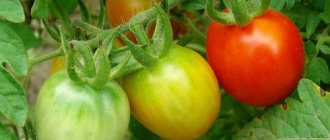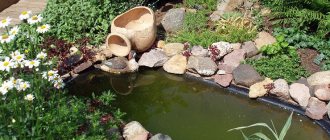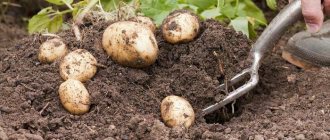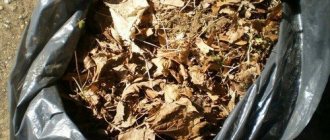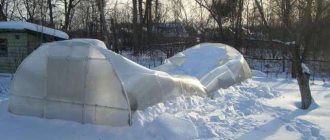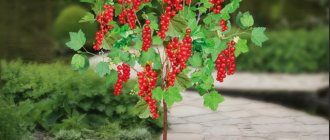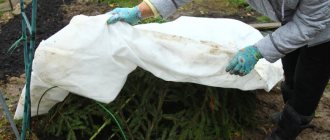Mix up the pile
Accelerating the maturation of this type of natural complementary food is achieved by mixing and turning the compost heap. Experienced gardeners do not recommend leaving the layers of which it consists in its original form (untouched). In this case, the microorganisms will be poorly supplied with air. Lack of oxygen will negatively affect their activity. Turning the compost heap will improve its aeration. Microorganisms will receive enough oxygen, and the ripening process of the fertilizer will accelerate.
In spring, it is advisable to thoroughly mix the layers to solve the problem of uneven decomposition. This happens when fresh bait components are placed on organic waste that has already begun to rot. In this case, the lower layer will ripen much earlier than the recently added one. Turning the compost heap and thoroughly mixing fresh components with already rotted ones will help ensure uniform maturation of the compost. The latter will play the role of a starter for the newly added organic matter, accelerating its processing by microorganisms.
It is necessary to turn the compost heap with a shovel or pitchfork regularly, at least once every 30 days.
Ways to accelerate ripening when laying and caring for compost
In addition to maintaining proportions when using additives, it is necessary to take into account the order in which the components are placed in the bag. Proper placement and subsequent care of the heap will reduce the ripening time of the compost. When forming a heap, several conditions must be met:
- all components, except the bottom layer, must be crushed;
- the bottom layer is not crushed - it is drainage;
- mix a bunch with additives (natural or mineral);
- all contents are thoroughly mixed - this creates an environment for the development of microorganisms that promote ripening;
- it is necessary to control humidity, avoiding excessive or insufficient moisture;
- For better ripening, use limiting containers: bags, pits, boxes, barrels.
The choice of specific measures depends on the additives used, the selected container for maturation, and oxygen access (absence - anaerobic method, presence - aerobic method).
In the compost pit
One of the simplest ways to create an environment for compost to mature is to prepare a hole. It is not necessary to dig it, it is enough to fence off the place where the organic remains will be placed with walls. If you dig a hole in the ground, then no deeper than half a meter to avoid excessive moisture. When placing components in a pit, it is necessary to form a pile of several homogeneous layers:
- bottom layer: large pieces (branches, wood cuts, turf) - drainage;
- nitrogen: mown grass with a layer thickness of 20-25 cm;
- emitting gases: clay or manure 2-5 cm thick diluted with carbon additives;
- another nitrogen one;
- the top layer of heterogeneous remains of fruits or vegetables.
The mass will heat up to approximately 70 °C during the first two weeks and then cool down. The prepared environment will become favorable for the activity of worms, which will help fertilize the heap
.
When composting in barrels
To speed up the maturation of compost, a device that you can make yourself is used - a composter. A homemade unit consists of two parts: an axis of rotation, a barrel. All raw materials are placed in a barrel, in which they are mixed while rotating. To load raw materials, the barrel body is equipped with a lid, as well as holes for air access.
Additionally, for more efficient mixing, the barrel is evenly pierced over the entire area with nails, which with the sharp part inside the container will loosen the compost mass.
In addition to the holes on the surface, there is a cover for oxygen access. Within a week, the mass should be infused with the lid open to obtain large volumes of air. After scrolling, the lid is opened again to infuse.
When composting in boxes
Composting boxes are used in the same way as placing them in a pit. According to the same principle, the raw materials are laid in layers from drainage and nitrogen to the upper heterogeneous carbon. The boxes can be plastic (sold in stores) or wooden, a common feature is holes for ventilation. The wooden container is created with your own hands from square bars 5 cm wide and 150 cm long. The bars are supplemented with boards 2.5 cm thick so that the mass does not fall out of the box. The size of the box is at least 1 meter in any dimension. Filling is done in the same order as for a compost pit.
Add herbal infusion
The use of herbal infusion will help speed up the maturation of the compost pit. This is an effective folk remedy. To obtain it, a set of ingredients is used:
- finely chopped weeds - 5 parts;
- poultry droppings (chickens) – 2 parts;
- water – 20 parts.
The greens are mixed with droppings and filled with water. The mixture is mixed and covered tightly with a lid. Then the container is left in a sunny place for 7-10 days. The prepared liquid is poured over the compost heap.
Experienced gardeners install bird feeders over the pit in which the compost matures. This allows you to further enrich the fertilizer with such a valuable component as bird droppings.
How to make compost?
Laying a compost pit begins with making a box. You can buy a plastic one, make a wooden one yourself, or dig a regular hole. In the latter case, the place is equipped with wooden logs. The material is placed in layers. You can also place them in any order. The main thing is to ensure oxygen access from the top and sides of the compost heap.
It is possible to place the “compost” on the surface of the earth. A recess is first dug for the bayonet of the shovel. Branches of bushes or trees are laid at the bottom. Next comes the compostable material. The pile is surrounded with boards or netting to give it shape. The top of the structure is covered with earth.
The formation of a compost pit occurs as follows:
- Hard raw materials are crushed into smaller parts. The soft is mixed with the hard to achieve the necessary looseness.
- The thickness of each layer varies within 15 cm. Thicker rows will make it difficult for air to penetrate inside.
- Very dry raw materials are first wetted with water.
- 700 grams of lime are poured onto the top of the next layer. It would not be superfluous to add 300 g of ammonium sulfate and 150 g of superphosphate to each row. The first component can be replaced with bird droppings at the rate of 4.5 kg of the latter instead of 450 g of sulfate. Wood ash replaces lime. Urea will add value to the final rotting result.
- The normal size of a compost heap is approximately 1.5 m2. With such proportions, the optimal ratio of temperature and humidity inside is maintained.
- When the heap reaches a height of 1.5 m, it is covered with earth to a level of approximately 5 cm.
- The laid layers are covered with film or other waterproof material.
It is necessary to ensure that the compost heap is moderately moist.
How to choose a place for a “compost”?
A shady area that does not receive direct sunlight is an ideal location for the compost bin. In such conditions, the required humidity is easily maintained. Moisture promotes a large accumulation of worms and woodlice: the presence of beneficial insects ensures a uniform decomposition process.
Spill water
A simple way to speed up the ripening process of this type of natural fertilizer is to water the compost heap with water.
Drying out of organic waste is unacceptable. This slows down the ripening of the fertilizer. To ensure that the preparation of compost does not take too long, you will need to water it regularly.
The optimal speed of compost ripening is achieved with abundant watering of the heap, once a month. In this case, you will need to stir the layers with a pitchfork. Warm water is used for irrigation. Its temperature must exceed +25°C. The best effect is achieved when watering the compost heap not with clean water, but with the addition of fermented jam, marmalade, jam, compote. These components will play the role of compost maturation accelerator.
Experienced gardeners dig a hole next to the compost heap and transfer part of the organic mass there. Then water the contents. This allows for better moisture in the ripening compost. It will reach readiness faster - in 5-6 months.
Over-wetting a compost pit is just as harmful as letting it dry out. It threatens to wash out useful substances from the future fertilizer. To avoid excessive saturation of the organic mass with moisture, you will need to cover the pile with plastic wrap in rainy weather.
The main problems that arise during the compost maturation process.
The biological process does not always go smoothly. The following difficulties may arise:
- There are ants inside the compost heap. This is a sure sign of lack of moisture - you should water the mass.
- The compost heap smells unpleasant. The phenomenon occurs due to the fact that a significant amount of soft elements is embedded. It is necessary to turn over the compost pile and add straw, paper or dry leaves.
- There are too many midges hovering over the compost heap. The problem arises due to excess moisture - the mass must be dried. To do this, it is left open for several days.
- There are no processes observed inside the compost bin. In this case, there is not enough moisture or moist elements. The pile should be shed or green grass should be added.
Compost is a valuable organic fertilizer. In order for it to rot correctly and bring maximum benefits, you need to know the features of its preparation and feeding.
How is compost different from humus?
When talking about organic fertilizers, many gardeners perceive the words “humus” and “compost” as synonyms. Others, on the contrary, consider these to be separate varieties.
Going deeper into the details, the following points should be highlighted:
- humus is rotted manure that acquires an earthy, loose mass; it may contain impurities of straw and grass;
- Compost is already a combination of 2 or more components, stacked in layers.
How is compost different from humus?
If you call compost humus, there won’t be a big mistake - in both cases, organic matter is over-rotted.
Ingredients for cooking
To obtain good compost, it is difficult to do without knowledge about the structure of a compost yard and filling the compost pit. The speed of compost maturation directly depends on the optimal ratio of the individual components of this fertilizer.
It is necessary to create favorable conditions for the activities of the smallest organisms. This requires air, water, heat and nitrogen. When choosing ingredients for compost, remember that nitrogen is the main nutritional element for microorganisms.
Compostable materials include those that are high in nitrogen (N) but low in carbon (C), and those that are low in nitrogen and high in carbon. Materials with high nitrogen content decompose faster. They emit heat, which is necessary for more active work of bacteria and fungi in the compost heap.
Nitrogen rich ingredients:
Mowing grass
Liquid manure; Bird droppings; Herbs after cleaning the garden; vegetable waste; green leaves; freshly cut grass; Pulse; Traces of nettles.
Materials saturated with carbon are less susceptible to rotting, but provide good air exchange and retain moisture.
Some of them:
straw
Straw; Chips; Dust; dried leaves; Branch; remains of marsh plants; tree bark.
Special signs
Knowing the subtleties will speed up maturation.
If the compost does not decompose a month after laying, then it lacks nitrogen. The problem can be corrected with the help of urea. For 10 liters of water you will need 2-3 matchboxes of the product.
An unpleasant smell of rotting indicates an excess of nitrogen. The organisms inside the heap grow rapidly, absorb too much oxygen and eventually die from lack of it.
Straw, which needs to be mixed with compost, will help correct the situation. It will get rid of excess nitrogen and improve the penetration of oxygen into the substrate.
What is garden compost
Summer residents call compost “garden gold.” It is used as mulch and fertilizer. The use of humus helps increase plant fertility, retain moisture in the soil and protect against diseases.
Compost can be prepared from organic matter of animal and plant origin, placed in a common heap. The process of decay involves microorganisms that decompose the collected waste. Among the symbiotes one can also distinguish worms and insects.
Garden compost
Note! For compost to be of high quality, microbes need 3 main components: food (organic matter), water and oxygen.
